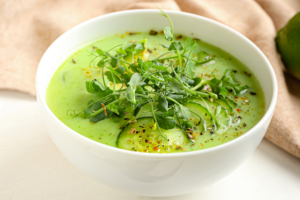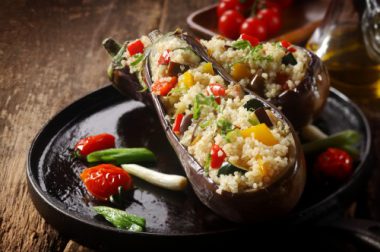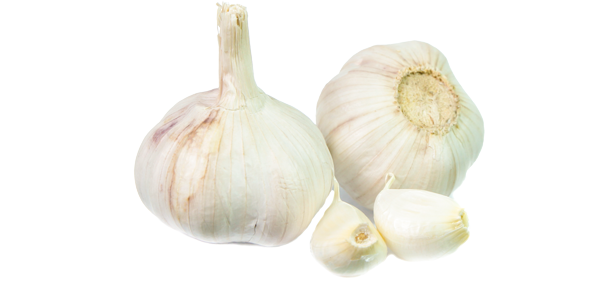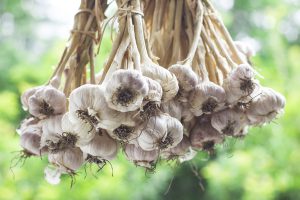Recipes we love
See all recipesGarlic butter
A sauce that brings out the best in fish and grilled vegetables: even the reluctant vegetable eater ...
Garlic sauce
For a more velvety texture, add a dash of cream. A tasty sauce to liven up fish and vegetables, raw...

Celery salad with garlic
Associating crispy and crunchy is a good way to seduce the gourmands. ...
Health
benefits
Garlic smells like sulfur?!
The smell of garlic is, well, unique! What’s more, it is easy to identify, whether you like it or not. The presence of sulfur compounds is what makes it so distinctive. These molecules are freed each time you smash, grind, or chop garlic. These gestures are far from insignificant, because they transform alliin (inactive and odorless) into allicin, which is responsible for the characteristic smell of garlic. Next, the allicin undergoes other chemical modifications; the compounds formed are thought to offer numerous health benefits.
Small but high in fiber
Garlic is naturally rich in fiber, especially soluble fiber, of which inulin is the best known. Inulin promotes regularity and helps stimulate bowel movements, in part because of its favorable effect on the growth of good bacteria in the colon, such as all prebiotics.
A condiment that replaces salt
As a condiment, meaning that it is consumed in small portions, garlic provides low quantities of these vital nutrients. That is a good reason to eat it regularly, especially because its flavor makes it possible to reduce the use of salt in cooking!
Garlic also contains:
- phosphorus
- potassium
- manganese
- selenium
- vitamin C
- vitamin B6
- vitamin B1
- antioxidants (flavonoids and tocopherols)
Tableaux de valeurs
nutritionnelles
When is the right
time to eat it?
All year.
Garlic is generally harvested in spring (pink or white garlic) and in autumn (purple garlic). However, it is available year-round and can be easily stored, meaning you can cook with it as much as you want, no matter the season.
Vegetable patch or
urban balcony?
Garlic is a bulbous perennial that thrives in sunny spots in light, well-drained soils rich in clay and lime or clay and sand and grows in temperate areas.
To learn everything you need to know about growing garlic, read the page on growing advice. Click here for more growing advice.
Choosing and
storing garlic
Choose the right garlic :
- Press on the head of garlic. The cloves should be firm to the touch.
- Do not buy garlic with green shoots; the shoot is harder to digest.
- It is sold dry, partially dry, and fresh.
Properly store garlic :
- Depending on the variety, garlic can be stored from between three to nine months, even up to one year.
- Fresh garlic is more delicate and should ideally be stored in the vegetable drawer in the refrigerator and should be consumed quickly.
- Keep heads of dry or partially dry garlic in a dry place, away from light, at an ambient temperature, because cold temperatures and humidity set off the germination process.
Tips and
tricks
How to prepare garlic
Whether raw or cooked, chopped, crushed, or whole, garlic has all kinds of uses! It can also be found in the form of powders, flakes, grains, pastes, and more.
No matter the kind, garlic should not be overcooked to prevent it from becoming bitter. It should be cooked slowly on low heat.
Tips for removing the skin from a garlic clove: Place the flat of a kitchen knife blade on the clove and push on the blade with your hand to lightly crush the clove; the skin will come off very easily.
How do you get rid of garlic breath? Brushing your teeth doesn’t work at all! You can chew on parsley, mint, or coffee beans after the meal to reduce garlic breath, but you still need to be patient. The characteristic smell comes from gases that are freed in the mouth when the garlic is chewed and in the digestive tract throughout digestion. It takes at least three hours to eliminate the gases!
It goes well with…
Whether as a condiment or garnish, garlic can be inserted into a roast, pressed into a sauce, or rubbed on bread or on a salad bowl to fill it with flavor. It will elevate the flavor of your dish.
As a condiment, meaning that it is consumed in small portions, garlic provides low quantities of nutrients. That is a good reason to eat it regularly, especially because its flavor makes it possible to reduce the use of salt in cooking!
Roasted garlic (garlic cooked in the oven) is also delicious in a purée or a sauce or rubbed on bread, croutons, or pizza crust.
How do you make roasted garlic? Cut off the top of the bulb to expose all the cloves. Wrap it in parchment paper or aluminum foil. Put it in the oven at 180°C (350°F) for about 45 minutes. Allow it to cool to a lukewarm temperature, then delicately squeeze the bulb to make the cloves come out.
Garlic is, of course, one of the typical ingredients in Mediterranean cuisine. It is the base for the Provençal pistou (a sauce of garlic, olive oil, and basil); Italian pesto (a sauce of olive oil, basil, parmesan, garlic, and pine nuts), eaten with pasta; and aioli from Marseille (a mayonnaise enhanced with garlic), an accompaniment for steamed vegetables and fish soup.
It also goes wonderfully with sautéed vegetables (tomatoes, eggplant, zucchini, bell peppers, and more), pasta, salads, vinaigrettes and sauces, and soups, to name a few.
Anti-waste tip: Don’t throw away the green shoot of new garlic! Chopped finely like chives, it is a delicious addition to salads.
Can people of
all ages eat it?

Young children
Even before birth, the fetus can perceive certain aromatic compounds from garlic in the amniotic fluid that cross the placental barrier.
Similarly, if the mother eats garlic while nursing, her baby can enjoy it too. These early introductions to the taste of garlic will help the child enjoy it later (Schaal et al., 2000).
Once children begin to eat solid food, they can be offered cooked garlic from the age of eight months, in small quantities.
And everyone else
No matter how old you are, garlic is easier to digest cooked than raw! Depending on the digestive sensitivity of each individual, garlic can just be used to flavor dishes by removing it at the time of serving.
See plenty of other tips for encouraging children to eat vegetables
Where do they come from?
Origins and varieties
Origins
Grown throughout the world, notably in China (the biggest producer in the world), in California in the United States, and in Spain, Romania, Italy, and France, garlic comes in over 700 varieties.
Varieties
The different garlics are available, either fresh or dry, depending on the time of year. They are distinguished by their color (white, pink, purple) and their intensity of flavor.
Of course, where they are grown plays a major role in the quality of taste of the garlic. There are many quality labels that vary from country to country. Ask your greengrocer for advice!



 Cabbage
Cabbage  Jerusalem artichoke
Jerusalem artichoke  Vegetable garden: growing melon
Vegetable garden: growing melon 










